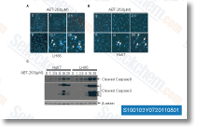Alternatively, we recommend that U0126 blunts receptor upregulation, Right here, we have demonstrated nevertheless a further beneficial effect of U0126. blocking the enhanced expression of MMP 9, which participates during the destruction in the BBB and sub sequent brain oedema. Extra importantly, systemic administration of U0126 markedly decreased the infarct size and improved neurological function, even if the 1st dose was offered as late as 6 hours immediately after the initiation of reperfusion. Obviously, these data differ to some degree from people discovered in earlier reviews. Although U0126 is known as a well known inhibitor of MEK1 2, it has a questionable perme capability with the BBB. So that you can conquer this hurdle, we utilised a a great deal larger dosage of U0126 than that used by others, which still didn’t alter any physio logical parameters and was effectively tolerated through the rats.
This dosage is substantially greater selleck Stattic than that important to inhibit the MEK ERK pathway in cell culture but is important to allow a ample dosage to reach the abluminal side in the BBB. this was verified by protein expression utilizing the two immu nohistochemistry and western blot. We verified the suc cess from the antagonism by demonstrating that MCA and cerebral microvascular pERK1 two routines were decreased to regulate levels and this reduction was related with a sig nificant reduction in infarct dimension and diminished expression of MMP 9 and TIMP 1. If U0126 treatment method was initiated 12 hours right after the LY500307 start of reperfusion, there was no signif icant impact around the above parameters. For that reason, at this dosage, the MEK1 inhibitor U0126 might have a therapeu tic window.
Conclusion We hypothesise that MEK ERK inhibition could signify a way to avoid stroke induced pathology since it tar will get several transcriptional mechanisms activated by cere bral ischemia, this kind of as receptor upregulation, which triggers enhanced contractility, and MMP 9 and TIMP1 activation,  which have an effect on the function in the BBB. Inhibition with the MEK ERK pathway utilized as late as six hours after the start of reperfusion significantly reduced the infarct volume as well as expression of BBB associated proteins MMP 9 and TIMP1 within the cerebral vessel walls. As a result, the positive effects of MEK ERK inhibition may well involve several mechanisms within the MCA and in brain microvasculature associated with all the cerebral ischemia.
which have an effect on the function in the BBB. Inhibition with the MEK ERK pathway utilized as late as six hours after the start of reperfusion significantly reduced the infarct volume as well as expression of BBB associated proteins MMP 9 and TIMP1 within the cerebral vessel walls. As a result, the positive effects of MEK ERK inhibition may well involve several mechanisms within the MCA and in brain microvasculature associated with all the cerebral ischemia.
PCNA signal
PCNA is a member of the so called DNA
